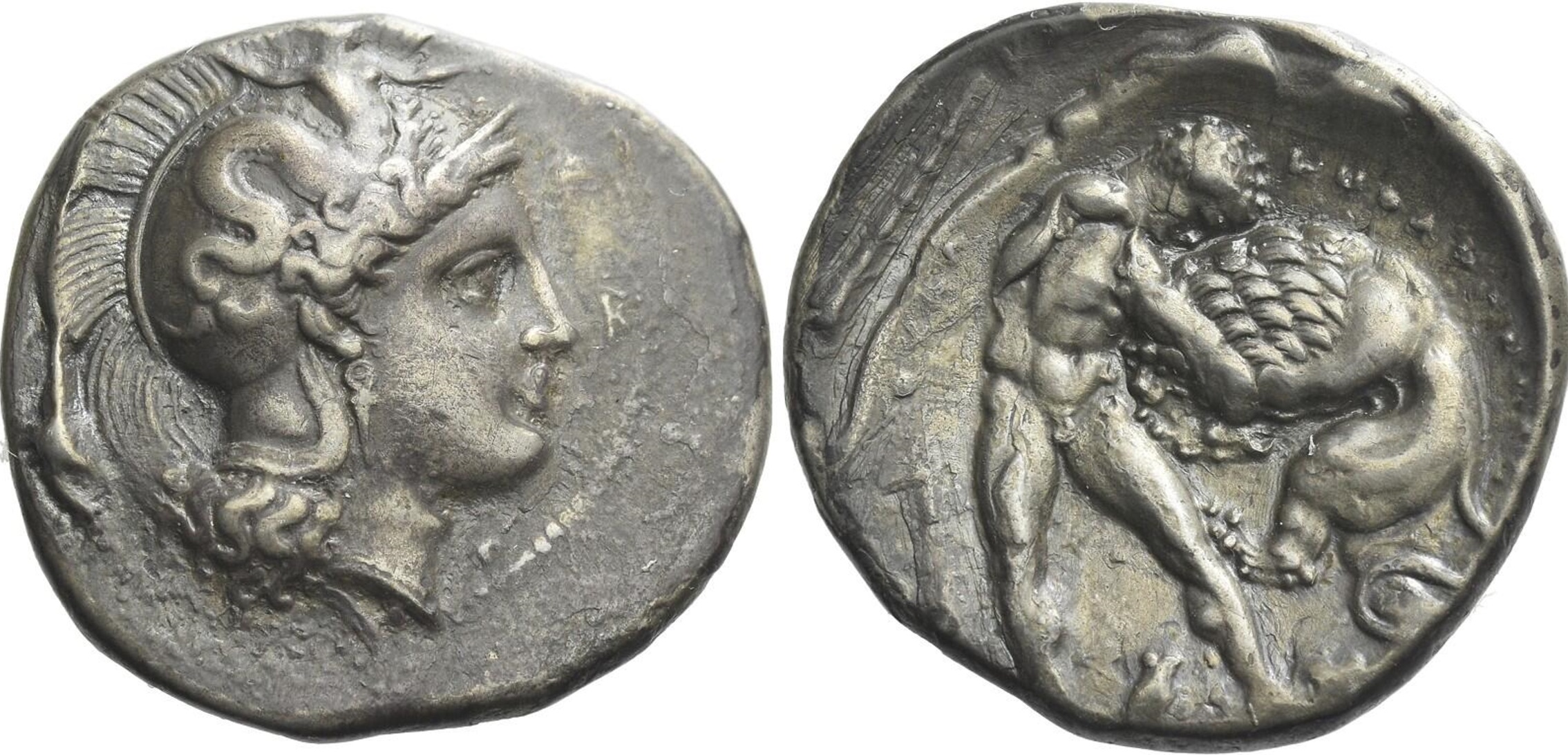390 BCE - 340 BCE | ΗΡΑΚΛΗΙΩΝ
Overstriking coin
Heraclea_Lucaniae_Numismatica_Ars_Classica,_30_Sept._2024,_45_(bis).jpg
[1]
|
|
Sale(s)Sale(s) ᵖ:
|
Rollin & Feuardent, 19 Dec. 1921, 19 = Numismatica Ars Classica, 30 Sept. 2024, 45
|
| Private collection(s)Private collection(s) ᵖ:
|
From the P. Matthey, Lloyd and Mentor collections.
|
|
Description
| ObverseInscription or printing placed on the obverse.:
|
Head of Athena r., wearing Attic helmet decorated with Scylla hurling stone, in r. field, Δ – Κ – Φ.
|
ReverseInscription or printing placed on the reverse.:
|
ΗΡΑΚΛΗΙΩΝ (Greek) Heracles standing r., strangling the Nemean lion, between Heracles' legs, owl, to the l., club. In upper l. field, KAΛ
|
Mint and issuing power
| MintIdentifies the place of manufacture or issue of a numismatic object.:
|
Heraclea Lucaniae
|
Ancient regionAncient region.
|
Lucania
|
Modern countryModern country: Italy
|
AuthorityIdentifies the issuing power. The authority can be "pretended" when the name or the portrait of X is on the coin but he/she was not the issuing power. It can also be "uncertain" when there is no mention of X on the coin but he/she was the issuing power according to the historical sources:
|
|
Chronology
| FromIdentifies the initial date in a range assigned in a numismatic context. 390 BCE toIdentifies the final date in a range assigned in a numismatic context.. 340 BCE
|
Classical 480-323 BC  periodTime period of the numismatic object. periodTime period of the numismatic object.
|
Physical description
MetalThe physical material (usually metal) from which an object is made.: Silver 
|
WeightWeight of the numismatic object (in grams). in grams: 7.547.54 g <br />7,540 mg <br />
|
DenominationTerm indicating the value of a numismatic object. Examples: tetradrachm, chalkous, denarius.: nomos
|
|
| DiameterDescribes diameter of an object (in mm).: 2525 mm <br />2.5 cm <br />
|
|
References
| Coin referenceReference of the Coin:
|
Work 1940, n° 39d (this coin). SNG Lloyd, n° 272 (this coin)
|
Coin series referenceReference to coin series study:
|
Work 19401Work 1940, n° 39d (this coin), SNG Lloyd2SNG Lloyd, n° 272 (this coin), Van Keuren 19863Van Keuren 1986, n° 50, HN Italy4HN Italy, n° 1377, HGC 15HGC 1, n° 977
|
| Coin series web referenceCoin series web references:
|
|
Description
| ObverseInscription or printing placed on the obverse.:
|
|
ReverseInscription or printing placed on the reverse.:
|
|
Mint and issuing power
| MintIdentifies the place of manufacture or issue of a numismatic object. ᵖ:
|
|
Ancient regionAncient region. ᵖ
|
|
Modern countryModern country:
|
AuthorityIdentifies the authority in whose name (explicitly or implicitly) a numismatic object was issued. ᵖ:
|
|
Chronology
| FromIdentifies the initial date in a range assigned in a numismatic context. toIdentifies the final date in a range assigned in a numismatic context..
|
periodTime period of the numismatic object.
|
Physical description
References
References
- ^ Work, Eunice (1940), The Earlier staters of Heraclea Lucaniae, NNM 91, New York, no. 3-48.
- ^ Sylloge Nummorum Graecorum, Great Britain Vol. 2 : The Lloyd Collection. Part 1-2 Etruria to Thurium, Part 3-4 Velia to Eryx, Part 5-6 Galaria to Selinus, Part 7-8 Syracuse to Lipara
- ^ Van Keuren, Frances (1986), "The late staters from Heraclea Lucaniae (281-272 B.C.) : additional evidence on the reduction of the south Italian and Romano-Campanian standards", Convegno del Centro internazionale di studi numismatici (7th : 1980 ...). La monetazione di Naepolis nella Campania antica Napoli, p. 413-427, 2 pl.
- ^ Rutter N. Keith et alii (eds.) (2001), Historia Numorum Italy, London, xvi, 223 p., 43 pl.
- ^ Hoover, Oliver D. (2018), The Handbook of Greek Coinage Series, Volume 1. Handbook of Coins of Italy and Magna Graecia, Sixth to First Centuries BC., Lancaster-London, 2018, lxi, 527 pages, 23 cm

